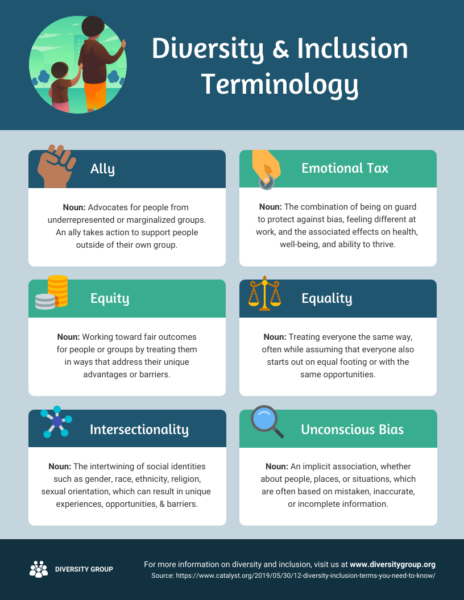What Does Diversity and Inclusion Look Like in a Modern Workplace?

Tumisu / Pixabay
Modern workplaces require modern initiatives. The same old Diversity and Inclusion techniques you’ve been rocking out for 10 years won’t cut it in 2020.
In 2020 your Diversity and Inclusion initiatives need to become proactive, not reactive. It’s no longer enough to wait for an incident to occur before you hold you staff to a higher standard. You need to ensure that you’re practicing D&I across the board, across your business, every single day.
Moving from a passive D&I strategy to an active one can be a daunting task, but there are small steps you can take to make your workplace a more welcoming and inclusive environment.
1. Use inclusive terminology whenever possible
Make a point in your company to use inclusive language as standard. Here is a glossary of some terms that may be helpful to know
[Diversity & Inclusion Infographic Source]
Try and avoid using gendered language when talking about individual or groups of employees. Be aware that each of your employees will bring a different set of experiences with them, and be mindful of dismissing opinions or ideas that are based on a different experience.
2. Make you Diversity & Inclusion program employee-led
Employees know how they best want to be treated and are in a great position to help create any D&I program. Too often HR or Management outsource Diversity & Inclusion to companies who claim to run great courses or initiatives without checking in with their actual employees about what they want.
Running a survey, or asking employees to attend an open discussion or forum about how your workplace current is, and what you can be doing better can be a great first point. If you want to be an inclusive and welcoming workplace, start from the ground up and make sure that diverse voices across every level of your company are heard and respected.
3. Value your employees’ unique experiences
Employees increasingly want a company culture that values them as individuals and places wellbeing above all else. Part of creating that culture rests with your Diversity & Inclusion work.
Acknowledging that there is more than one path to success is a great way to start building a more inclusive company. Things like removing the requirement of a College degree and valuing experience instead is a great first step.
You can also actively create space for employees to share their knowledge through Lunch and Learns, or through internal newsletters.
Part of your D&I work should also focus on career progression tracks, and removing barriers for progression. Requirements for promotion like the length of service can work against those who have had to take time off for caring responsibilities.
4. Assess the success of your Diversity & Inclusion on a regular basis
You wouldn’t set a project live and not check back in Marketing or Engineering. Make sure to be accountable for your Diversity & Inclusion work by creating regular check-ins, and reporting progress with the whole company.
Here are some of the key Diversity & Inclusion questions you can ask yourself:
- What is the makeup of your Senior Management team?
- What is the makeup of your overall workforce?
- Do employees feel valued?
- How are complaints handled?
- Do employees feel welcomed?
- Are marginalized voices being heard?
- Are their ideas being enacted?
- Do we have a process in place for fair recruitment?
- Do we have a process in place for feedback?
Once you have a baseline for your company, you can start to measure the results of your Diversity & Inclusion work. Conducting company surveys every quarter can be one way to measure success.
Business & Finance Articles on Business 2 Community
(31)


